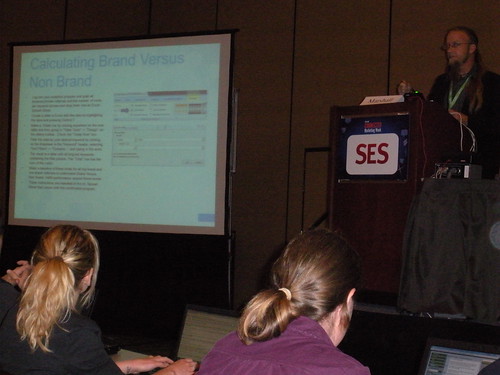 Ultimately, to measure Search Engine Optimization (SEO) success, you aren’t necessarily looking at individual metrics – you are looking for a connection between the metrics – and the resulting affect on revenue.
Ultimately, to measure Search Engine Optimization (SEO) success, you aren’t necessarily looking at individual metrics – you are looking for a connection between the metrics – and the resulting affect on revenue.
If my lead seems to negate the name validity of the SES San Francisco session, ‘Meaningful SEO Metrics,’ it is completely unintentional.
Moderated by John Marshall, CTO of Market Motive and SES Advisory Board Member, this excellent session featured on its panel:
- Richard Zwicky, Founder & CEO, Enquisite
- Ray “Catfish” Comstock, Director of SEO, BusinessOnLine
- Jon Glick, VP of SEO and GM European Web Properties, Become.com
“Infinitely measureable means adjustable,” opens Zwicky. “And online marketing is completely measureable.”
A Key Performance Indicator (KPI) Zwicky recommends companies and marketers look at is Share of Voice, or in other words, how much traffic are you receiving for a keyword or phrase when compared to the balance of the marketplace?
Online tools, from Google Trends to Tweetscan, can measure the amount of traffic or conversation generated by competing websites or in social platforms to give you an idea of just how much voice is out there. It’s not perfect, but it’s measureable.
Another KPI from Zwicky is attribution across channels. For example, plot out the sales your company achieves on a local or nationwide map. Next map out visits from social media, local media buys – or any other metric you would like to compare against. You now have a quick and dirty map that can be used to compare your metrics and help measure the effectiveness of your tactics.
Zwicky’s map segues nicely into Comstock’s keyword metrics, specifically branded vs. non-branded traffic, long-tail keyword traffic and personalized vs. local rankings.
Branded keywords, traffic coming to your site via queries containing your brand name, are oftentimes more an effect of outreach programs while non-branded are an effect of SEO. Long-tail keyword traffic, the iceberg below the water, measures all the variations of popular keyword phrases driving traffic to your site. Finally, personalized vs. localized rankings are everything that will appear above traditional search results – at times wreaking havoc for those used to a certain ranking position.
Combine the insight of Zwicky and Comstock – for instance – analyze branded traffic in markets where media buys are heavier, and you have an indication of the effectiveness of your ad campaigns in driving traffic. Analyze corresponding revenue and you have an indicator of the effectiveness of your ad campaigns towards sales.
Glick closes the session by continuing to urge audience members to see how data fits together, and to implement the types of tests that will show these connections.
‘Pseudo A/B testing,’ the process of adding new features to subsets of pages, can help illustrate the connections between minor and major website updates and corresponding changes to the bottom-line. Pseudo A/B testing offers infinite possibilities for analyzing the types of changes that can be made to compel bottom-line results when implemented sitewide.
The path towards online success is driven by data of a different stripe daily.
What metrics, or connections, have you found beneficial to look at?


